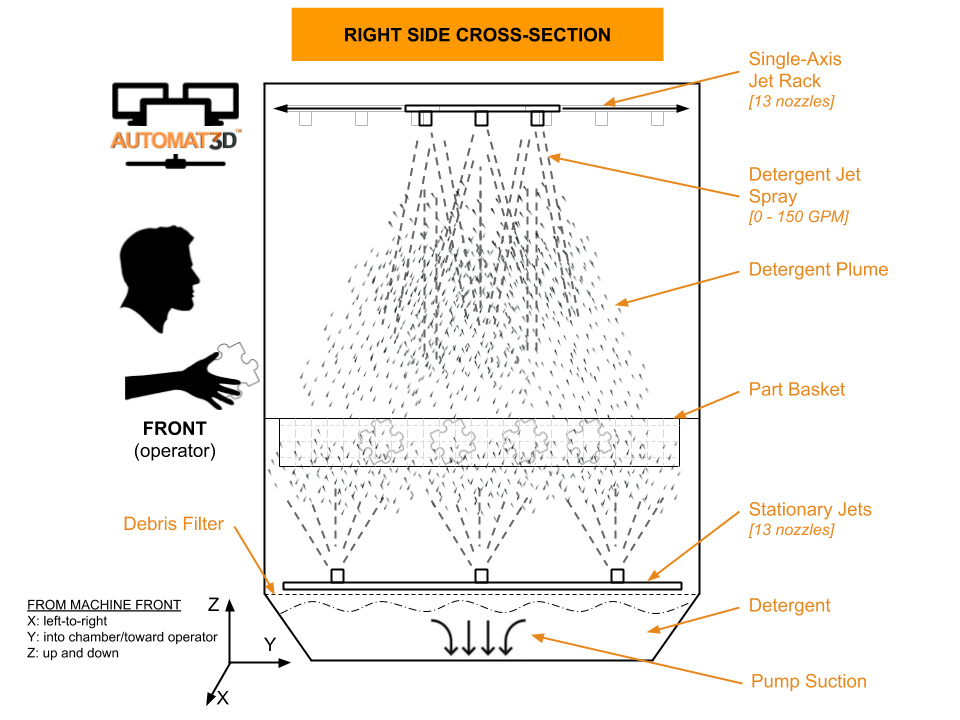Automated post-processing system manufacturer PostProcess Technologies has been granted a U.S. patent for its Volumetric Velocity Dispersion (VVD) technology.
VVD is the company’s spray-based support removal process, and is featured in PostProcess’ BASE and DECI systems. Primarily intended for use with FDM, SLA, CLIP, and PolyJet 3D printed polymer parts, the technology is software-driven, and utilizes the company’s patent-pending detergents.
Daniel Hutchinson, Founder and CTO of PostProcess Technologies, states, “This recognition comes not long after the patenting of our SVC technology, so we are delighted to add yet another PostProcess innovation to our repertoire of pioneering technologies. It’s clear to see that our commitment to trailblazing the automated post-printing industry is making a significant impact on helping users reach production scale as we strive to close the digital loop and further digitalize the additive landscape.”

Volumetric Velocity Dispersion
The proprietary VVD technology is one of five in PostProcess’ portfolio. Machines featuring VVD use a series of high-volume bi-directional jets, together with a perpendicular linear motion, to mechanically spray off polymer support structures. The jet streams, depending on the system, vary between 150 – 200 gallons per minute (over 750 liters per minute), but only exert a pressure of 35 PSI. This high-volume, low-pressure combination serves to deliver fast cycle times with no damage to the 3D printed parts, keeping geometries intact.
Directionally, the flow is all-encompassing, meaning the sprayed parts are kept in place and do not circulate in the processing chamber. This means any potential collisions are avoided, further safe-guarding the geometry of the 3D printed parts. Users have the option to choose between three primary detergents, one for each of the core compatible 3D printing technologies (FDM, SLA, and PolyJet). Where relevant, the detergent also serves to dissolve soluble supports and wash off uncured resin, maximizing surface quality.
Working in tandem with the hardware and chemistry, the company’s AUTOMAT3D software is the driving force behind the VVD process. The program enables users to closely control the system’s energy sources, and parameters such as the temperature, pressure, pH, jet flow patterns, and rack movement. AUTOMAT3D also allows for recipe storage, meaning users can re-use successful parameter combinations for a more consistent workflow.

Patent-protected end-to-end workflows
The VVD patent, issued on the 1st of December, is now one of more than 50 filed by the company worldwide. They cover everything from software to hardware and consumables across each of the five post-processing technologies. The company has already stated that counterpart patents for the VVD process are currently pending in a number of other countries.
Just last month, the company announced the launch of its latest technology family. Dubbed Variable Acoustic Displacement (VAD), the patent-pending polymer powder removal technology is specially designed for use with SLS and MJF 3D printed parts. Earlier this year, PostProcess also announced that it had been granted a U.S. patent for its Submersed Vortex Cavitation (SVC) technology. SVC is the company’s second support and resin removal technology, and works by immersing a 3D printed part in a proprietary detergent while rotating it in a mechanical drum with vortexes.
Subscribe to the 3D Printing Industry newsletter for the latest news in additive manufacturing. You can also stay connected by following us on Twitter and liking us on Facebook.
Looking for a career in additive manufacturing? Visit 3D Printing Jobs for a selection of roles in the industry.
Featured image shows the BASE support removal system. Photo via PostProcess Technologies.


